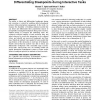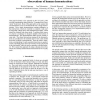8099 search results - page 49 / 1620 » Higher-Order Task Models |
CHI
2007
ACM
15 years 10 months ago
2007
ACM
The ability to detect and differentiate breakpoints during task execution is critical for enabling defer-to-breakpoint policies within interruption management. In this work, we ex...
TII
2008
14 years 9 months ago
2008
Embedded control systems are often implemented in small microprocessors enabled with real-time technology. In this context, control laws are often designed according to discrete-ti...
ICRA
2002
IEEE
15 years 2 months ago
2002
IEEE
This paper describes a new approach on how to teach a robot everyday manipulation tasks under the “Learning from Observation” framework. Most of the approaches so far assume t...
NECO
2008
14 years 9 months ago
2008
We analyze a neural network model of the Eriksen task, a twoalternative forced choice task in which subjects must correctly identify a central stimulus and disregard flankers that...
NAACL
2004
14 years 11 months ago
2004
Previous work demonstrated that web counts can be used to approximate bigram frequencies, and thus should be useful for a wide variety of NLP tasks. So far, only two generation ta...


